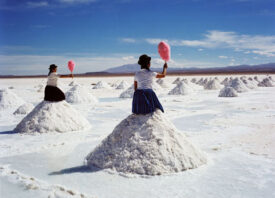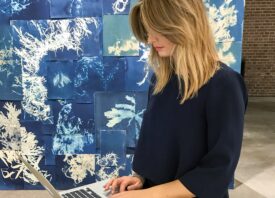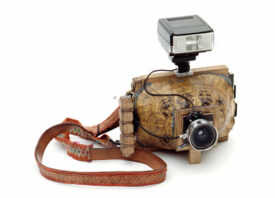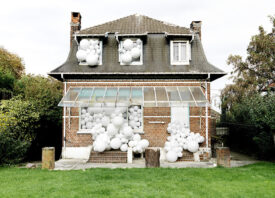Search this site
Finding Magic in the Remotest Corners of the Earth

Burka Balloons, 2014. “Local women of the Almahrah tribe dressed in black burkas holding white balloons on the southern shores of Socotra Island. In Yemen it is forbidden for women to show their bodies or their faces in public outdoors.” © Scarlett Hooft Graafland, Courtesy Flowers Gallery London and New York.

Turtle, 2013. “A naked girl on the shore of Lake Itasy covers herself with the shield of a turtle. Many turtle species are endangered in Madagascar because of the flourishing trade in their shields.” © Scarlett Hooft Graafland, Courtesy Flowers Gallery London and New York.
Amsterdam photographer Scarlett Hooft Graafland craves places far from home, where the noise of city life recedes into an infinite expanse of open air, untamable terrain, and all things wild. Her roaming heart has taken her to some of the most isolated corners of the earth, including the salt desert of Bolivia, the island of Socotra in Yemen, the forests of Madagascar, the Inuit territories of Nunavut, Canada, and most recently, the islands of Vanuatu.
Discovery, now on view at 21 Cork Street in London, Hooft Graafland’s first solo exhibition at Flowers Gallery, featuring large-scale C-type prints, all made directly from the artist’s negatives. The pictures in the show span thousands of miles and more than ten years of Hooft Graafland’s life.
When people appear in Hooft Graafland’s boundless landscapes, they’re usually locals she’s gotten to know through much time spent in the area. Her tableaux vivants are made in collaboration with members of the community; she researches their mythologies, and she abides by their rules and customs.
Almost nothing is accidental in Hooft Graafland’s world, and while her work is certainly witty— humor is important to her— there are also darker undercurrents running beneath the surface. In Vanuatu, rising sea levels and climate change pose an urgent threat. In Madagascar, a nude wears a turtle shell, a nod the endangerment of local turtle species.
Hooft Graafland’s theatrical scenes, staged in the pristine and natural environments, don’t leave behind any reminder that they ever were. She packs up and moves on, and the negative is all that remains. In many ways, the artist is homesick for places that never existed and probably never will, but that doesn’t stop her from searching.
Scarlett Hooft Graafland: Discovery is on view at Flowers Gallery in London until April 29th, 2017.

Seven Steps to Overlapping Beauty, 2004. “A native Bolivian, carrying rubber boats, makes a journey in a pool of water on the salt flats. This inflated shape is a reference to the macho character ‘Hulk’, a popular cartoon in the region.” © Scarlett Hooft Graafland, Courtesy Flowers Gallery London and New York

Discovery, 2006. “A gigantic cactus between a naked woman’s legs. This cactus has grown for 200 years on Isla del Pescado, a small island rising up in the middle of the world’s largest salt desert.” © Scarlett Hooft Graafland, Courtesy Flowers Gallery London and New York

Fish, 2012. “Seven wooden canoes on the shore of Belo sur Mer, with seven pairs of knees of fishermen protruding from their boats. There is hardly any fish left in this part of the Mozambique Channel, and fishermen are often out of work and idle.” © Scarlett Hooft Graafland, Courtesy Flowers Gallery London and New York.

Angèle, 2013. “A yellow-faced student and prostitute at the ‘Red Tsingy’ stone formation in the north of Madagascar, where a mixture of yellow wood dust is often used as sunscreen to protect the skin from the strong sunlight.” © Scarlett Hooft Graafland, Courtesy Flowers Gallery London and New York.

Dunes Like You, United Emirates, 2016. “Five Arab men at the foot of the Al Hajar Mountains, wearing one long pink ‘Keffiyeh.’ In the United Emirates men show their social status by the type of headdress they wear.” © Scarlett Hooft Graafland, Courtesy Flowers Gallery London and New York

Resolution, Malekula, Vanuatu, 2015. “An 11-year-old boy holding a yellow model ship of the HMS Resolution on the beach of Malekula Island. The boy is a descendant of the chief of the tribe that welcomed Captain Cook to the island, two and a half centuries ago, when Cook’s ship laid at anchor at the same spot.” © Scarlett Hooft Graafland, Courtesy Flowers Gallery London and New York



